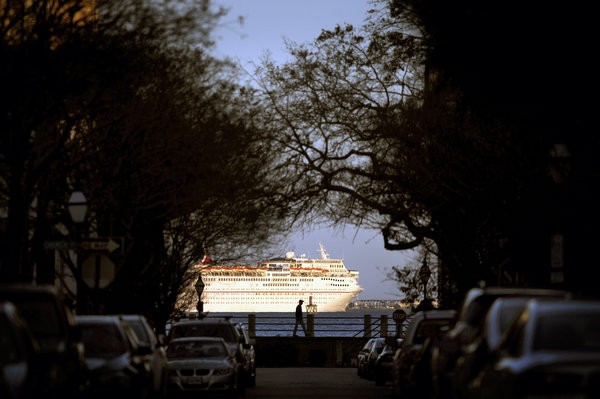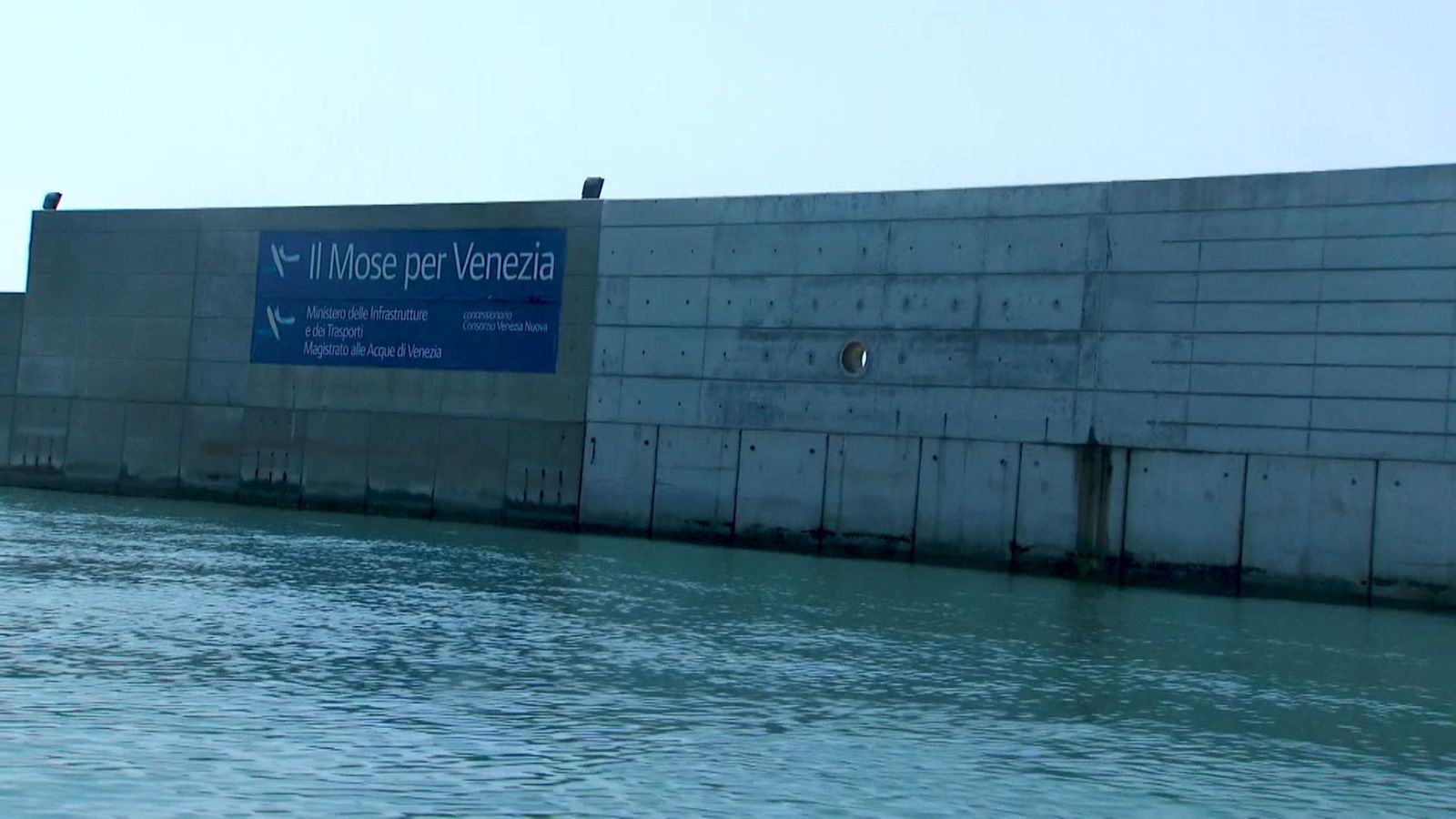CHARLESTON, S.C. — In this Southern coastal city that runs on history and hospitality, a raucous civic debate belies a genteel veneer.
Like several communities that hug the nation’s coastline, Charleston is struggling to balance the economic benefits of cruise ships against their cultural and environmental impact.
Last week’s debacle aboard Carnival Cruise Lines’ Triumph, in which an engine fire stranded 4,200 people in the Gulf of Mexico for five days, has done little to deter those civic leaders who believe that building a new $35 million cruise terminal will be a great boon for this port city.
But for people like Jay Williams, a homeowner in the historic district who writes a blog for Charleston Communities for Cruise Control, a preservationist group, the nightmare on the Triumph is one more piece of evidence in the case against a fast-growing form of travel. “Cruise ships are sardine cans packed with passengers and crew, susceptible to horrific accidents that instantly can put thousands at risk for their lives,” he wrote after the episode.
Cruising has never been more popular or affordable, with its mix of easy travel, exotic locales and onboard amenities that include cooking schools and simulated surfing. In 2012, cruise ships carried 20 million passengers, the majority of them from the United States. With 14 new cruise ships entering the water in 2014, the number of passengers is expected to increase by as much as 8 percent.
But on the shores of the nation’s most charming cities and towns, the relationship is complicated.
In Key West, Fla., voters will decide this fall whether to spend $3 million toward widening a channel that leads to the city’s ports, where 350 cruise ships arrive each year. A deeper channel would allow a new, larger class of cruise ships to dock. Business owners and residents worry that the dredging would hurt fragile coral reefs and overwhelm the town.
In Alaska on Tuesday, state lawmakers rolled back tough wastewater standards mandated by voters in 2006. The bill, backed by Gov. Sean Parnell, will allow the 36 cruise ships that travel Alaska’s waters each year to discharge wastewater with less treatment than it currently receives.
Michelle Ridgway, a marine ecologist who serves on the state science panel for cruise ships, watched as Alaska cruise ship traffic grew to about a million people a year and changed her hometown, Ketchikan. “The pulp mill closed and the place turned into Disneyland,” she said.
Charleston’s cruise ship debate seems small by comparison, but it is deeply felt.
The Fantasy — at 23 years old, the oldest ship in the Carnival fleet — has been based in Charleston since 2010. It slides into port once or twice a week. Some 2,000 passengers, most of whom have driven in from nearby states, walk through an aging terminal, climb aboard and sail off to the Bahamas or the Caribbean for a few days or a week. Other cruise ships sometimes stop to visit the city, too.
The South Carolina Ports Authority wants to build a new ship terminal that port officials say will handle only one ship at a time, but the frequency of ships could increase.
Those dedicated to preserving a section of town whose buildings date to the 1700s worry that a new terminal will bring a damaging concentration of tourist traffic and larger cruise vessels.
“I can’t believe they are doing this to Charleston,” said Carolyn Dietrich, who lives just a few blocks from the terminal. “I can hear the announcements from my house,” she said. “And that black smoke. It just tumbles out of that smokestack. You should see the dust in my car.”
Port officials point out that cruise ships are a tiny slice of the city’s shipping traffic. More than 1,700 vessels use the port every year, and only 85 of those are cruise ships. And cruise traffic, they say, is worth $37 million a year to the region.
But this city takes its preservation seriously. The specter of more cruise ships has spawned three state and federal lawsuits and has placed the city’s historic district on the World Monuments Fund’s list of most endangered cultural sites.
The intensity of opposition has the usually composed mayor, Joseph P. Riley Jr., baffled and angry. “This thing is hard to understand because it’s not logical,” he said. “This is not a theme park. One of the authentic parts of Charleston is that we are an international port.”
He points out that the city will get a new waterfront park, and that it has an agreement with the port that caps the number of ships a year at 104.
People wary of cruise ship traffic want the limit to be legally binding. They also want the ships to plug into electrical power on shore, a newer technology only some ships have. (Shore power exists at some Alaska and California ports and is in the process of being adapted at the Brooklyn Cruise Terminal in Red Hook.)
But mostly, they want the port to consider two other spots along the waterfront, which the mayor and port officials say are unworkable.
Not that cruise ship passengers worry too much about the impact their vacations have on local communities. Battles over local or federal legislation, like the Clean Cruise Ship Act, which died in Congress in 2010, are not as interesting as which name-brand chef is going to open a restaurant on board.
“Our audience doesn’t really respond to the municipal-level battles or the environmental stuff,” said Dan Askin, senior editor at cruisecritic.com, a consumer Web site dedicated to cruise ships.
The cruise ship industry has less comprehensive oversight than the airline industry, which is regulated by the Federal Aviation Administration. Ships fly under foreign flags and their parent companies are incorporated overseas, leaving regulation to a patchwork of federal, state and, rarely, local laws.
That puts more responsibility on local communities that host cruise ships, said Marcie Keever, oceans and vessels program director at Friends of the Earth, an environmental group. “They need to not just listen to the cruise ship industry or assume regulations are in place,” she said. “They need to talk to other cities that have gone through this.”
A cautionary tale might be found in Mobile, Ala., where Carnival Cruise Lines hauled the lifeless Triumph last week. Mobile would gladly take any cruise ship traffic at all. The port and the city romanced Carnival Cruise Lines for years. In 2004, after the city borrowed $20 million to build a terminal, Carnival finally agreed to the relationship and based a ship there.
In 2007, Carnival named Mobile its port of the year. Things were going so well that in 2009, Mobile spent $2.6 million on a new gangway. Two years later, Carnival left.
The location just wasn’t popular enough, it said, and rising fuel costs made Mobile a less efficient port than New Orleans.
“It’s a mobile fleet so they can move to a place that is giving them the best deal,” Mr. Askin said. “That’s good for the companies, but bad things start to happen to cities when ships bail out.”
 Comitato No grandi navi Comitato No grandi navi – Laguna bene comune
Comitato No grandi navi Comitato No grandi navi – Laguna bene comune




